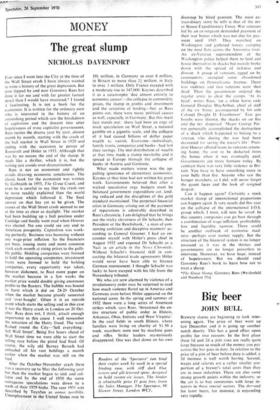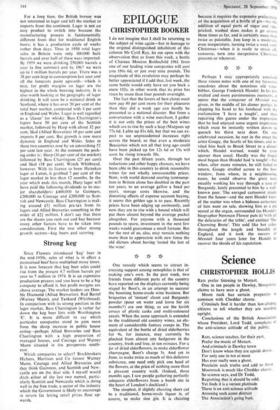Big beer
JOHN BULL
Brewery shares are beginning to look inter- esting again. The price of beer went up last December and it is going up another notch shortly. This has a good effect upon profits for two reasons. In the first place these Id and 2d a pint rises are really quite large because so much of the money you pay across the bar goes in duty. In relation to the price of a pint of beer before duty is added, a 2d increase is well worth having. Second, wages and salaries are a rather smaller pro- portion of a brewer's total costs than they are in most industries. There are also some strong growth points within the industry, so the art is to buy companies with large in- terests in these snecial sectors. The demand for laver beers, for instance, is expanding very rapidly. For a long time, the British brewer was not interested in lager and left the market to imports from the continent. Lager is not an easy product to switch into because the manufacturing process is fundamentally different from that for traditional English beers; it has a production cycle of weeks rather than days. Thus in 1950 total lager sales in Britain were only 100.000 bulk barrels and over half of these were imported. By 1959 we were drinking 250,000 barrels a year (a fine summer) and by 1967 we were up to 1 million barrels per year. There was a 38 per cent leap in consumption last year and all the forecasts point upwards—which is nice, for profit margins on lager are the highest in the whole brewing industry. It is also worth looking at the geography of lager drinking. It will soon be a national drink in Scotland, where it has over 20 per cent of the total beer market, compared with 4 per cent in England and Wales. Lager is well regarded as a 'chaser' for whisky. Bass Charrington's lagers have 50 per cent of the Scottish market, followed by Harp with about 32 per cent, Skol (Allied Breweries) 10 per cent and imports 8 per cent. But growth is now more dynamic in England and Wales. Sales in these two countries rose by an astonishing 52 per cent last year. At the moment the peck- ing order is: Harp (30 per cent of the market) followed by Bass Charrington (25 per cent) and Skol (18 per cent). Watch Whitbread, however. With its licence to brew Heineken lager at Luton, it grabbed 7 per cent of the lager market in less than 12 months. In the year which ends this month, Harp lager will have paid the following dividends to its ma- jor shareholders: £400,000 to Guinness, £200,000 to Courage and £200,000 to Scot- tish and Newcastle. Bass Charrington is mak- ing around Of million pre-tax from its lagers and Allied Breweries something in the order of i21- million. I don't say that these are the shares you rush out and buy because many other factors have to be taken into consideration. First the two other strong growth sectors—keg beers and catering.



































 Previous page
Previous page